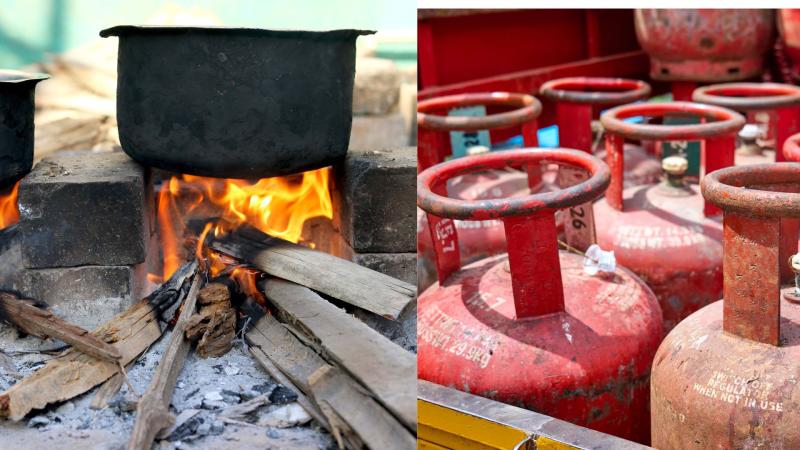
Cooking fuel pollution in India has been a severe problem, primarily caused by the widespread use of solid biomass fuels, such as wood, dung, and crop residue, particularly in rural areas. This traditional practice leads to high levels of indoor and outdoor air pollution, contributing to millions of premature deaths annually from respiratory and cardiovascular diseases. Global warming further exacerbates the suffering of populations, as pollutants trap increased amounts of heat. Amidst the gloom, one unexpected yet important ray of hope is unfolding in the forests of Jharkhand.
Researchers from the Indian Institute of Science (IISc), Bengaluru, the Birla Institute of Technology and Science (BITS), Pilani, and the Institute of Forest Productivity, ICFRE, Ranchi, have been studying how a government initiative aimed at providing clean cooking fuel has led to a remarkable greening trend. The phenomenon, detailed in a recent study, highlights the connections between social welfare, energy policy, and ecological restoration.
Did You Know? In India, biomass cooking with traditional methods, though decreasing, remains significant, with 41% of the population still relying on wood, crop residue, and cow dung |
Rural communities in many developing nations have heavily relied on firewood for cooking, a practice that significantly contributes to deforestation, indoor air pollution, and climate change. India, with its vast rural population, has been at the forefront of this challenge. Recognising the multifaceted problems associated with traditional cooking fuels, the Indian government launched the Pradhan Mantri Ujjwala Yojana (PMUY) in 2016. The scheme aimed to provide capital cost subsidies for Liquid Petroleum Gas (LPG) connections to poor households and forest-dwelling communities. In Jharkhand, the scheme has achieved significant success, with LPG access increasing from a mere 25% in 2015 to an impressive 75% by 2020.
The researchers set out to assess the environmental impact of this rapid energy transition. To do this, they employed a rigorous methodology, combining satellite data analysis with on-the-ground field surveys. They used MODIS-NDVI time-series data spanning from 2002 to 2020, covering the forested areas of Jharkhand. The extensive dataset enabled them to compare forest health before (2002-2015) and after (2016-2020) the widespread implementation of the Ujjwala scheme.
To ensure the robustness of their findings, they accounted for confounding environmental factors, including temperature, precipitation, and forest fires, in their models. These models helped them determine the Normalised Difference Vegetation Index (NDVI), a satellite-derived measure of vegetation greenness. It also allowed them to isolate the residual NDVI, the changes in vegetation greenness that natural climate variations or fire incidents couldn't explain.
Their study, focusing on Jharkhand, provides the first systematic evidence at a provincial scale that the switch from firewood to LPG has triggered a significant increase in forest biomass, a phenomenon known as greening. The results showed a substantial increase in the measured NDVI. The magnitude of the residual NDVI was positively correlated with the number of LPG connections across different administrative blocks in Jharkhand. This meant that areas with higher LPG adoption showed greater forest recovery, even after accounting for natural environmental influences.
To further validate these findings, the team conducted household-level field surveys in 20 forest-fringe villages within the Hazaribagh district, a representative area of Jharkhand. These villages were categorised into greening and non-greening clusters based on their NDVI trends. The surveys confirmed that villages experiencing significant greening had higher LPG coverage and, crucially, reported a substantial reduction in firewood consumption by an average of 209.52 ± 21 kg/year per household, or 37.33% overall, with even higher reductions in firewood consumption in greening villages.
Many previous studies have primarily focused on the village-level impacts of adopting clean fuels. Providing compelling evidence at a provincial scale demonstrates that government initiatives can indeed have large-scale positive impacts on socio-ecological systems. While the findings are promising, the researchers also acknowledge certain limitations. COVID-19 restrictions constrained the field surveys, and a complete LPG refill history was not available for all sampled households. Furthermore, the lack of ground-level LPG data beyond 2020 limits the assessment of long-term sustainability. A critical observation was the relatively low LPG refill rates in Jharkhand (1.97 refills per year per household) compared to the national average (3.2) and normal consumers (7). This suggests that while initial adoption is high, sustained use remains a challenge, potentially jeopardising the environmental gains.
Nonetheless, environmentally, the study offers a tangible pathway for forest conservation and climate change mitigation. Reduced firewood extraction directly lessens pressure on forests, allowing them to regenerate and sequester more carbon. Socially, the Ujjwala scheme has already improved the health and quality of life for millions of women and children by reducing exposure to harmful indoor smoke. This study adds an ecological dimension to these benefits, demonstrating how social welfare programs can simultaneously contribute to environmental sustainability.
The findings also underscore the importance of not just providing initial access to clean energy but also ensuring its sustained use through ongoing support, such as targeted subsidies for LPG refills. This could make clean energy affordable for the poorest households, preventing a return to traditional, environmentally damaging practices to foster both human well-being and ecological resilience.
This article was written with the help of generative AI and edited by an editor at Research Matters.





